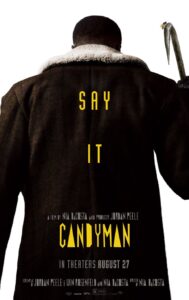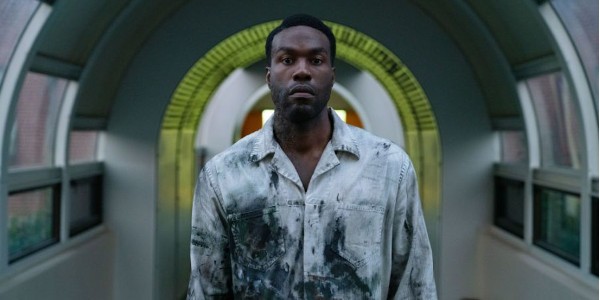“A story like that, a pain like that lasts forever.”

Candyman is a 2021 MGM release directed by Nia Dacosta. The screenplay was written by DaCosta, Win Rosenfeld, and Jordan Peele. The film is a sequel, not a remake or reboot of 1992’s Candyman, which was based on a short story by Clive Barker, The Forbidden, published in The Books of Blood anthologies in 1984-85.
Following in the trend of ignoring inconvenient sequels like Superman Returns does with two of its predecessors, there were follow-ups to Candyman, ‘95’s Candyman: Farewell to the Flesh, and Candyman: Day of the Dead in 1999, but this film pretends they never happened.
The first Candyman depicts graduate student Helen Lyle’s (Virginia Madsen) investigation of a localized urban myth centered in Chicago’s Cabrini Green housing project, and the horrible fate that befell her. Helen’s focus is on the legendary Candyman, Daniel Robitaille. (Tony Todd) The Candyman is a towering, horrible, hook-handed revenant associated with bees, who can be summoned by saying his name five times in a mirror.
DaCosta’s film picks up many years later. The bulk of Cabrini Green has been razed and rebuilt into high-end apartments. Brianna, (Teyonah Parris) an art gallery director, and her artist boyfriend Anthony, (Yahya Abdul-Mateen II) are relaxing in her opulent duplex after meeting her brother Troy’s (Nathan Stewart- Jarrett) new boyfriend, Grady. (Kyle Kaminsky) Troy tells them the story of Helen, the Candyman, and her gruesome end.
Anthony’s painting has been stuck in a rut, and the notion of the Candyman intrigues him. With the help of a long-time resident of Cabrini, William, (Colman Domingo) Anthony begins to delve deeper into the Candyman mythos and unearth his own past, only to find that some things are better left buried.
Inspired, he creates work after work spawned from William’s tales. He puts on a solo show based on the lynching of Robitaille and the oppression and abuse of the over-patrolling Chicago Police in the Cabrini Green projects. Using the legend of the Candyman as a hammer, and the many mirrored installations in the exhibit as an anvil, Anthony’s art dares the viewers to say his name. When that inevitably happens, the consequences are appalling.
At the same time, Anthony continues to work feverishly and his obsession spins out of control, threatening his burgeoning art career and his relationship with Brianna. The line between legend and real-life blurs and breaks down as the bodies begin to pile up.
This movie was a pleasant surprise. Having been disappointed over and over again by the seemingly endless stream of unnecessary reboots, retcons, and remakes that Hollywood spews out on a regular basis, discovering that this movie is an actual sequel to the original film was very gratifying. After a 29 year wait, this movie can join Tron: Legacy, Sin City: a Dame to Kill For, Bladerunner 2049, and Mobile Suit Gundam: Hathaway, among others, in the “decades-delayed-sequel” club.
While the first Candyman was more of a horror-tragedy-romance (with horror), this is more of an urban anti-hero origin story. There is a great deal of social commentary embedded in this film, and the class and race arguments made are overt. After herding minorities and other undesirable parts of the population into the public housing projects of Cabrini Green, the city promptly ignored them and allowed them to rot. Then, using the excuse of the horrible conditions and crime, they tore down the projects and invited developers to rebuild for the gentrifying crowd, providing tax breaks and incentives for galleries and luxury towers.
This movie is not subtle. With the exception of one of William’s flashback scenes, every single person whacked by the Candyman really, really deserves it. Most of the kills are White, insouciant, rich, and petty. They are almost uniformly depicted as hostile, toxic invaders of a once wildly different community. And then there are the cops. Never around when you need them, never serving nor protecting, but negligently tromping around like impetuous elephants through the grass.
This is a pretty good movie. DaCosta is a patient director, content to let her actors do the heavy lifting, which they do with aplomb. The screenplay pops with wit. These are well-rendered, real people in a real world, who are aware of things called “horror movies”. There are many wonderful moments when Brianna just nopes her way around several tropes, like the dark staircase leading to the drippy basement. She’s just like, “Yeah, nope.” It happens a few times, and it’s kind of great.
The music by Robert A.A. Lowe is discordant and jangly at times, often rushing in when least expected. It makes for wonderful atmospherics and when combined with the tight editing of Catrin Hedström, his score keeps you anxious and involved.
There is a wonderful cameo by Tony Todd towards the end, and the movie really does due justice and respect to its progenitor. I have only two problems with this movie; one is simply aesthetic. Possibly to prevent aping the slow-footed serial killers of yore, when not traveling within reflective surface to reflective surface like a low-rent Mirror Master, the Candyman’s mode of transportation is a cloud of bees. This hook-handed, towering figure of menace glides gracefully, deliberately, suspended by a cloud of bees. Yes, it looks as silly as it sounds.
The second is more of a structural issue. The film feels like the double-sized, first issue of a comic book. It’s the origin story of a new Candyman for a new century, instead of a standalone film, but that’s ok. It’s not a dealbreaker. This movie deserves a sequel, as a sequel is an apt reward for a smart final girl.
Say his name.
Candyman opens in theatres on August 27th.

